Marine cranes are essential equipment for a wide variety of industries that require heavy lifting operations at sea or on land. The versatility of marine cranes allows them to handle and lift a wide range of loads and cargo, including containers, machinery, equipment, and even small vessels. The use of marine cranes in the maritime, shipping, and oil and gas industries is critical to ensuring efficient and safe operations.
The main purpose of a marine crane is to lift and transfer heavy loads between ships or from a ship to shore. The reach, lifting capacity and flexibility of the crane make it an indispensable tool for loading and unloading ships, as well as positioning and assembling equipment on offshore platforms. Marine cranes can handle loads from a few tons to 5,000 tons or more, and their jib lengths can extend to hundreds of meters.
The use of marine cranes is not limited to handling and lifting water loads. They can also be used underwater for subsea construction, installation and maintenance operations. Underwater cranes are designed to withstand the harsh marine environment and can operate at depths of hundreds of meters. They are used for tasks such as lifting and installing oil and gas pipelines, repairing underwater infrastructure, and recovering underwater objects.
In addition to offshore operations, marine cranes are also used in onshore locations such as ports, shipyards and industrial sites. They are used to load and unload containers, heavy machinery and equipment on trucks, trains or barges. Marine cranes are also used in the construction industry for the construction of bridges, dams and other infrastructure projects that require heavy lifting.

Marine cranes are available in different types and configurations to meet specific requirements. Some common types of marine cranes include hydraulic cranes, knuckle boom cranes, rigid boom cranes, telescopic boom cranes and lattice boom cranes. Each type of crane has its advantages and limitations, depending on intended use, load capacity and operating conditions.
Factors such as load capacity, outreach, jib length and operating environment should be considered when selecting a marine crane. Cranes should also be designed to meet industry standards and regulations, including safety requirements. Proper training and certification of crane operators and fitters is also essential to ensure safe and efficient operations.
Maintenance and inspection of marine cranes is essential to ensure their reliability and longevity. Regular inspection, lubrication and replacement of worn parts prevents breakdowns and reduces downtime. Proper storage and handling of a crane when not in use is also important to protect it from corrosion, moisture and other environmental elements.
In conclusion, marine cranes are essential equipment for various industries that require heavy lifting operations at sea or on land. Their versatility, capacity and range make them indispensable tools for loading and unloading ships, positioning and assembling equipment on offshore platforms, and handling heavy loads on industrial and construction sites. The use of marine cranes requires proper selection, training, certification, maintenance and inspection to ensure safe, reliable and efficient operations.
Post time: Jun-13-2023
 © Copyright - 2018-2021 : All Rights Reserved.
© Copyright - 2018-2021 : All Rights Reserved.